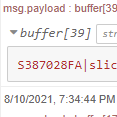SmartSDR v4.1.3 | SmartSDR v4.1.3 Release Notes
SmartSDR v3.10.15 | SmartSDR v3.10.15 Release Notes
The latest 4O3A Genius Product Software and Firmware
Need technical support from FlexRadio? It's as simple as Creating a HelpDesk ticket.
Remote operating and Node Red
Comments
-
Alan, I apologize that I am taking up so much of your time. Still getting errors. Here is my inject setup now..
just for fun I tried to wire the set msg.payload to the updateMeters node to see what I get...
thanks
0 -
Here are two examples on how to get meter data from "message" variables.
With a simple "debug" node:
With a "Change" Node". Allow you to add other stuff to the output:
0 -
And for Context Variables, two examples using "flow" variables (any node on the same tab can access the variable, thus, no wires:
Using a simple, "Inject" node into a debug node:
And, using a "Change" Node:
Alan
0 -
Alan,
Thank you. I was in the right area but did not put the pieces together...Here is my flow to adjust tmp based on range
0 -
The student has surpassed the teacher. Nice!
Alan WA9WUD
1
Leave a Comment
Categories
- All Categories
- 378 Community Topics
- 2.1K New Ideas
- 630 The Flea Market
- 8.2K Software
- 119 SmartSDR+
- 6.4K SmartSDR for Windows
- 183 SmartSDR for Maestro and M models
- 430 SmartSDR for Mac
- 271 SmartSDR for iOS
- 259 SmartSDR CAT
- 193 DAX
- 382 SmartSDR API
- 9.3K Radios and Accessories
- 38 Aurora
- 258 FLEX-8000 Signature Series
- 7.2K FLEX-6000 Signature Series
- 947 Maestro
- 56 FlexControl
- 865 FLEX Series (Legacy) Radios
- 924 Genius Products
- 463 Power Genius XL Amplifier
- 336 Tuner Genius XL
- 125 Antenna Genius
- 297 Shack Infrastructure
- 209 Networking
- 460 Remote Operation (SmartLink)
- 144 Contesting
- 787 Peripherals & Station Integration
- 139 Amateur Radio Interests
- 1K Third-Party Software












